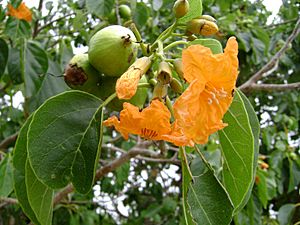Cordia subcordata facts for kids
Quick facts for kids Cordia subcordata |
|
|---|---|
 |
|
| Flower, fruit | |
| Conservation status | |
| Scientific classification | |
| Genus: |
Cordia
|
| Species: |
subcordata
|
The Cordia subcordata is a beautiful flowering tree. It belongs to the borage family, called Boraginaceae. You can find this tree in many places around the world. It grows in eastern Africa, South Asia, Southeast Asia, northern Australia, and the Pacific Islands. People know this plant by many different names. Some common names are beach cordia, sea trumpet, and even kerosene wood.
Contents
What People Call It
This amazing tree has many names depending on where you are. Some of its other names include kanawa, tou, kou, and manjak. In places like Java and Madura, people call it kalimasada, purnamasada, or pramasada. People in Java even believe this tree has special spiritual power. In the Marshall Islands, it is known as kono.
About the Tree
C. subcordata is a medium-sized tree. It usually grows to be about 7 to 10 meters (23 to 33 feet) tall. But sometimes, it can grow even taller, up to 15 meters (49 feet)! Its leaves are shaped like ovals. They are about 8 to 20 centimeters (3 to 8 inches) long and 5 to 13 centimeters (2 to 5 inches) wide.
Its Flowers
The flowers of C. subcordata are shaped like tubes. They are about 2.5 to 4 centimeters (1 to 1.5 inches) wide. These flowers often grow in pretty clusters. The Petals are a bright orange color, while the sepals (the leaf-like parts under the petals) are pale green. You can see this tree bloom all year long. However, it produces the most flowers during the spring season.
Its Fruit
This tree also grows fruit throughout the year. The fruit is round and about 2 to 3 centimeters (1 inch) long. When the fruit is fully grown, it becomes woody. Each fruit usually holds four or fewer seeds inside. These seeds are about 10 to 13 millimeters (0.4 to 0.5 inches) long. The fruit can float on water. This means they can travel long distances in ocean currents, helping the seeds spread.
Where It Lives
C. subcordata is a tree that loves the coasts. You can find it growing from sea level up to about 30 meters (98 feet) high. Sometimes, it can even grow at higher spots, up to 150 meters (492 feet). This tree likes areas that get a lot of rain, about 1000 to 4000 millimeters (39 to 157 inches) each year. It prefers soil that is not too acidic or too basic (pH of 6.1 to 7.4). This includes soils made from basalt, limestone, clay, or sand. It can grow in many types of soil, like sandy soil, loam, and clay.
How People Use It
The seeds of C. subcordata are safe to eat. People have sometimes eaten them when there was not much other food available. The wood of this tree burns very easily. This is why it got the nickname "Kerosene Tree" in Papua New Guinea.
The wood itself is quite light and easy to work with. It is also strong and resists termites. In ancient Hawaiʻi, people used kou wood a lot. They made ʻumeke (bowls) and other tools from it. They also made large containers called ʻumeke lāʻau. These big bowls could hold 8 to 16 liters (2 to 4 gallons) of food. They were used to store and ferment poi, a traditional Hawaiian food. The wood was good for this because it did not make the food taste bad.
The beautiful flowers of the tree were used to make lei, which are Hawaiian flower necklaces. People also made a dye from the leaves. This dye was used for kapa cloth (a type of fabric) and aho (fishing lines).
In the western Solomon Islands, in Vanuatu, on Waya Island, and in Tonga, the wood is used for carving. On New Ireland, its wood is always used to make special entrances for men's houses during ceremonies.
See also
 In Spanish: Cordia subcordata para niños
In Spanish: Cordia subcordata para niños


